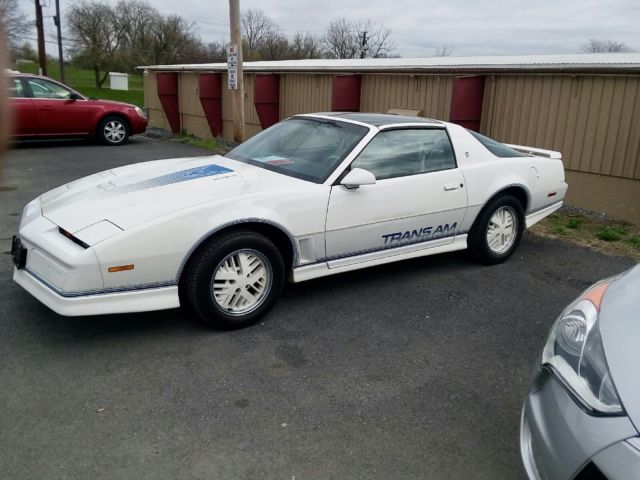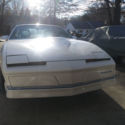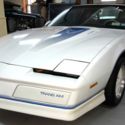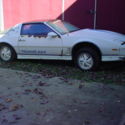1 of 1000 - Very Rare - Limited - 15th Anniversary Pontiac Trans Am
| Make: | Pontiac |
| Model: | Trans Am |
| SubModel: | Recaro |
| Type: | Hatchback |
| Trim: | 15th Anniversary |
| Year: | 1984 |
| Mileage: | 41,168 |
| VIN: | 1G2AW87G5EN232676 |
| Color: | White |
| Engine: | L69 - 5.0L - V8 |
| Cylinders: | 8 |
| Fuel: | Gasoline |
| Transmission: | Automatic |
| Drive type: | RWD |
| Interior color: | Gray |
| Drive side: | Left-hand drive |
| Vehicle Title: | Clear |
| Item location: | Coopersburg, Pennsylvania, United States |
1984 Pontiac Trans Am 15th Anniversary Additional Info:
Vehicle present is 1 of 1000 automatic 15th Anniversary Pontiac Trans Ams. Runs and drives with good overall paint condition. Has only 41k miles, clean title, Recaro seats, and many other limited edition features.
Please read the article below for all the information you need to know about it.
If you have any questions, please contact via text or call Patrick at 610.570.1788.
Speciality and rarity are the two traits that buyers yearn for in a performance car. Back in 1984, buyers who wanted the most distinctive and rare new performance car that America had to offer didn't have to look any further than the 1984 Pontiac Trans Am 15th Anniversary Edition. With only 1,500 produced and a unique exterior color scheme, anyone with a half of brain knew this was no ordinary Trans Am but one destined to be a future collectible. Driving a 15th Anniversary Trans Am back then let everyone know that you were part of a special club. It was the most expensive and exclusive Trans Am back in 1984. Even a mint conditioned 1969 Trans Am, a 1973-1974 Trans Am Super Duty 455, and every other previously produced Trans Am back in 1984 were all less expensive than the $17,500 (window) sticker price of the 15th Anniversary Trans Am. In other words back in 1984, there was not another Trans Am that was worth more or cost more than it. So for a Trans Am fan back in 1984 this was the Trans Am to own.
Of course with low production making these cars in such short supply, you can imagine many buyers paid more than sticker price to get their hands on one. The game was a simple one that some Pontiac dealers had learned back in 1979 with the wildly successful 10th Anniversary Trans Am - that all they needed to do was put the special edition car on the dealership floor and slap a dealer markup price of a few thousand dollars over sticker price and then wait until a buyer who was willing to pay the big markup arrived. And this system worked for these special edition Trans Ams since a buyer would always emerge who paid what the dealership demanded. Even if you found a dealership that wouldn't markup a special edition Trans Am, there was always some shrewd buyer who would buy one for around sticker price (and not title it) and then flip it for a quick profit of a few thousand dollars. And for the 15th Anniversary Trans Am this was also the case. In other words what this meant is that 15th anniversary buyers back in 1984 really wanted this car and jumped through hoops of fire to get one. You'll never hear a story about a buyer back in 1984 stumbling into a Pontiac dealership and buying one on a whim. Any normal buyer who may have even been smitten with the 15th Anniversary after accidentally stumbling across one, would balk at the high markup price and would thereby usually get the dealer sales pitch how he or she could get a better deal on another Trans Am just like it. And this wasn't such a bad thing since many buyers drove away happy in a 1984 Trans Am that was purchased for a lot less than the 15th Anniversary with many of the same options - 55,374 buyers to be exact bought regular Trans Ams for the 1984 model year. There was also a limited edition 1984 Trans Am Recaro Edition which was a black and gold Trans Am with Recaro seats - a low production special edition Trans Am that numbered only 1,321 units. And when you add these 1,321 Recaro Trans Ams and the 1,500 15th Anniversary Trans Ams to the final Trans Am tally, Trans Am production totaled 58,195 which made 1984 the best sales year for the third generation (1982-1992) Trans Am.
These were good times at Pontiac, its marketing team was using the sales slogan "We Build Excitement" to lure buyers into its dealerships. And when the buyers arrived at a dealership, there were plenty of different sporty and performance oriented models for customers with diverse tastes. Even in 1984, the Trans Am still lived up to its reputation providing some of the best styling, performance, and handling you were going to find in an American car. The third generation Trans Am had been a big success when it was released in 1982, and even by 1984 styling was still new enough to keep buyers happy. Starting in 1984 on the Trans Am there was a spoiler package which consisted of a lower body front air dam, side skirts, and front plates to cover up the twin grille openings (all these items were first seen on the 1983 Trans Am Daytona Pace Car Edition). The 15th Anniversary was standard with the side skirts, front air dam, and grille plates. However unlike the standard Trans Am which had the air dam, side skirts, and grille plate colored black or gold contrasting the main exterior color - the 15th Anniversary had all these pieces painted white to match the white exterior color which was the only color available for this special edition Trans Am. The 15th anniversary Trans Am was a glimpse of the new fad which would soon take performance cars by storm - having the exterior painted in one single color and this included most or all exterior trim pieces. In the 15th Anniversary's case, even the smoked-out rear taillights were outlined in white (unlike the standard Trans Am) along with the side mirrors and rear spoiler (which were both painted black on the standard Trans Am).
However this wasn't merely a white special edition Trans Am, it was one that payed the ultimate tribute to the first year low production 1969 Trans Am which was only available with a white exterior color accented with blue stripes. The 15th Anniversary also had blue stripes and decals (which included large blue "Trans Am" decal callouts). Most decorative of these, was the big hood stripe that covered the entire hood scoop which included as it's main attraction a modern rendition of the Trans Am bird.
A set of sporty white 16 x 8 inch aluminum wheels were standard with the 15th Anniversary package. Not only did these wheels give the Trans Am a sporty look, they also helped handling by being accompanied by sticky and wide P245-50VR16 Goodyear Gatorback performance tires. Worth noting, these Goodyear Gatorback tires were "VR" speed rated which meant they were safely able to drive for long periods, speeds in excess of 130 mph. No other 1984 Trans Am could be equipped with VR rated tires. The 15th Anniversary was also the only 1984 Trans Am that could be ordered with 16 inch wheels, the Recaro and regular Trans Am were stuck with 15×7 inch wheels with much narrower P215-65R15 Goodyear Eagle GT tires. The 15th anniversary also was standard with the WS6 handling package which along with the 16 inch wheels and wide tires yielded a very impressive .87 g on the skidpad as tested byMotor Trendmagazine(July 1984). This made the Trans Am back in 1984 one of the best handling cars in the world. The WS6 package included four wheel disc brakes which helped the 15th Anniversary Trans Am stop from 60-0 mph in a lightning quick 130 feet as tested byMotor Trend(July 1984).
Standard under the 15th Anniversary's hood was the Trans Am's top performance engine for 1984, the (L69) 5.0 liter (305 CID) H.O. V8 which was rated at 190 horsepower. This engine was first introduced in the Trans Am as a late-1983 model year option and produced 40 more horsepower than the LG4 5.0 liter V8 which was the base motor in the standard 1984 Trans Am. The 15th Anniversary's L69 produced 15 more horsepower than the hottest 5.0 liter V8 in the 1984 Mustang GT. The L69 was also a 1984 Chevrolet Camaro Z28 engine option and the mandatory engine of the 1984 Chevrolet Monte Carlo SS (with a 10 horsepower deficit). These L69 powered cars were among the fastest American made performance cars with a backseat in 1984, so a 15th anniversary Trans Am owner could rest assured that his or her car could go as fast as it looked - and with the 15th Anniversary's slippery shape it looked very fast even standing still. The 0-60 mph run only took 7.02 seconds and the 1/4 mile in a quick 15.44 seconds at 91.5 mph with the 5-speed manual transmission equipped 15th Anniversary (Motor Trend- July 1984). These were earth shattering performance times during this era. In fact 15 second range 1/4 mile times (before the L69),had not been obtainable with a Trans Am since the 1970s. Helping greatly to obtain such quick performance times was a standard 3.73 limited-slip differential - not since the original muscle car era had a Trans Am had such extremely low ratio rear gears. This meant that a parking lot burnout in this car was as easily obtainable as finding a bottle of soda at 7-Eleven.
190 net horsepower may have seem a little low by original muscle car era standards, however many today forget that horsepower figures in that original muscle car era were measured in the more lenient "gross" ratings versus the more stringent modern "net" ratings. What all this gibberish means is that the L69 if it was rated in gross horsepower would have produced at least 240 horsepower which was respectable horsepower during the 1960s especially from a small displacement small-block V8. Now add to the fact that the L69 was laden with modern pollution control devices including a restrictive catalytic converter that robbed horsepower (these are items the original muscle car era cars didn't have), and you soon realize without these devices horsepower would be a lot more. And like some of the legendary Pontiac muscle cars of original muscle car era, there was a standard Ram Air type induction system included with the 15th Anniversary Trans Am. Pontiac didn't really go out of its way to advertise it and the word "Ram Air" was never used. A largeopening on the top part of the air cleaner sucked cool air from the fully functional hood scoop. The hood scoop had a flap which was solenoid operated - as the accelerator approached the floor the flap opened and the loud (undeniable Rochester Quadra 4-bbl) moan from all four barrels opening on the computer controlled 750 cfm Rochester Quadrajet 4-bbl could easily be heard. This noise commotion would have you easily believing the original muscle car era never ended. The only real weakness of the L69 was its 240 lb-ft torque rating which was ample for a performance car at the time, but paled in comparison to the spine twisting torque of the golden era muscle car engines and even the 5.0 liter Tuned-Port Injected (TPI) V8 that replaced it (which on the average had almost 20% more torque than the L69). And to see how much torque has climbed in recent years, compare the L69 to a 2012 Mustang GT 5.0 liter (DOHC) V8 which has the same engine displacement of the L69 and produces a whopping 390 lb-ft of torque.
The 15th Anniversary was standard with a 5-speed manual transmission and optional with a 4-speed automatic. Both had overdrive gears so even with the ultra low3.73 rear axle ratio, low rpms were the norm at highway speeds. And with the efficiency of the L69 combined with the low engine rpms, driving 55 mph (the U.S. mandated speed limit back in 1984), up to 27 mpg was possible. An original era muscle car was lucky to get half that mpg figure doing the same highway driving.
The exhaust system on the 15th anniversary was a dual resonator and dual outlet setup after the single catalytic converter. The exhaust had a pleasant deep resonance muscle car tone, that made its presence known to even the most aloof of onlookers.
Pontiac during this era, when it produced special edition cars, generally went all out - there was usually no skimping. Some auto manufacturers would spend most of their effort on the exterior and leave the interior virtually untouched. Not the case with the 15th Anniversary which had a unique interior that couldn't be confused or mistaken for any other 1984 Trans Am interior. The 15th Anniversary came standard with with white leather Recaro seats with gray cloth inserts. These seats were just not attractive but they also provided some of the best lateral support you were going to find in a performance car during this era. Hitting the tight turns at higher speeds was not scary in this car since not only could the suspension handle it but the Recaros kept you firmly planted in the front seats in even the tightest of turns. And in case anyone forgot what model of car this was "Trans Am" callouts were all over the front and rear seats. And one "Recaro" callout was on each front seat. Fortunately Pontiac choice a dark gray color for the callouts that only provided a slight contrast with the slightly lighter gray cloth seat inserts which gave these seats a classy look as opposed to the same year Camaro Z28 with optional Lear Siegler seats that had numerous "Camaro" callouts that visually lit up the seats like modern Las Vegas at night.
Keeping in the spirit of the exterior color scheme the leather on the steering wheel, emergency brake handle, and shifter knob (both automatic and manual) were all white while the other 1984 Trans Ams used black leather in these areas. And three map pockets were white as opposed the black ones found in the standard Trans Am. The low driver seating position was also just right with an easily reachable center console andtransmission shifter. The gauge layout is among the best you'll find in a 1980s car - behind the steering wheel you feel more like you are in a well-laid out cockpit of an executive lear jet than a car. T-tops were also standard with the 15th anniversary edition, so the 1 to 2 minutes of time it took pack them away in the rear cargo area storage bag would yield the "almost convertible top down" motoring experience. And unlike a cloth top convertible which occupants nearly freeze in the cabin during the wintertime, T-tops provide most of the benefits of a hardtop the best of which include a warm passenger cabin even when its cold outside. Riding in one of these T-top equipped cars on a nice day has you firmly believing that GM, Ford, and Chrysler are all currently really missing the boat. As an example the current Dodge Challenger and Chevrolet Camaro both have borderless side windows and large flat roof areas that are perfect for the application of T-tops. Seeing how none of the modern muscle cars have T-tops only makes the appeal of cars like the 15th Anniversary Trans Am on a nice day that much greater.
Indeed the 15th Anniversary Trans Am was a special car, and that speciality as mentioned before came at a price. The only new American performance car back in 1984 that was more expensive was the Chevrolet Corvette. Ironically, in today's classic car market the 1984 Corvette has a lower resale value on the average when compared to the 1984 15th Anniversary Trans Am. Currently the 15th Anniversary is the highest price 1984 performance car on the classic car market. This is no surprise since it was uber special and ultra classy back in 1984 and it still remains so today. It was a special time capsule that commemorated fifteen years of one of America's finest performance cars, not just in exterior decor or livery but in the very good performance and handling it offered.
ABOVE ARTICLE:https://oldcarmemories.com/1984-pontiac-trans-am-15th-anniversary-edition-uber-special-and-very-classy/
VEHICLE BEING SOLD IS NOT THE FEATURED VEHICLE IN ARTICLE
























